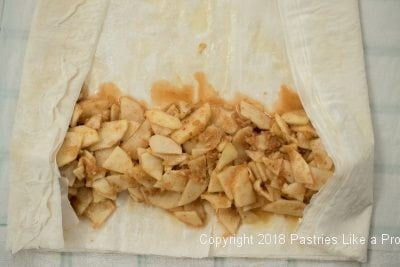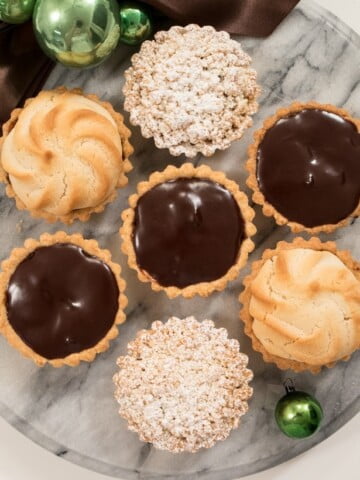
There was a round table covered with fresh white tablecloths on which it was pulled. My job was to sweep up the thin shards that would flake off as it was folded. The large single sheet extending over the edges of the table was folded over and over on top of itself, filled and baked. Fortunately, these days phyllo can be found frozen and I honestly cannot see any advantage to trying to make my own.
Phyllo is the piecrust of Mediterranean and Middle East cuisine. It can be used in sweet and savory dishes. Many, many years ago when I first became interested in food writing, I wrote a book with every type of recipe imaginable using phyllo. Unfortunately, publishers were not much interested. Phyllo is the correct spelling for this magical dough but it is also referred to as filo.
There are several brands of phyllo. The most important factor in buying the dough for this Apple Strudel is to make sure it is 18 x 13 inches. 
There is thick and thin phyllo. If a package does not specify, I assume it is thin as this is the most used. I haven’t been wrong in this assumption yet, but I guess there is always that chance.
It is best when making anything with phyllo to eat it the same day it is made. Having said that, if it is held over do not cover it with the exception of the cut end. Covering it will make the phyllo soggy.
Apple strudel is one of my favorites, but most fruit fillings will work. Initially, I used Granny Smith apples but I had Honey Crisp apples on hand and found those to be equally good as they don’t become mushy when baked. It important to make the filling first and allow it to juice, then add the crumbs. This should be completed before the phyllo layers are prepared.
Europeans don’t use starches to thicken filings as much as we do here. The juices that accumulate from the fruit and sugar used are thickened with buttered breadcrumbs. The ratio is 1 tablespoon butter per ¼ cup dried breadcrumbs. I keep a container of breadcrumbs in my freezer for various purposes. It is made from bread or rolls that have been dried and then processed into fine crumbs. I find this better than store bought crumbs that can sometimes be stale.
While Apple Strudel or any recipe made with phyllo has an unwarranted reputation for being difficult, I am going to show you how to more easily prepare the phyllo before it dries out. Because the leaves are so thin, it can dry out easily. Using the book method shown below helps avoid this.
When I decided to post this I did a quick turn around the internet. It was quite a trip. One person suggested the butter was used between the layers to “glue them together” which is the exact opposite of what should happen. Layer, upon layer of leaves, should end up flaky and distinguishable much like puff pastry.
Apple Strudel is actually an easy dessert to prepare which never fails to amaze people. Just prepare the filling first so everything is ready to go once the phyllo is buttered and sugared.
I hope this becomes a part of your dessert repertoire and that you make it over and over.
Apple Strudel
½ cup breadcrumbs (50 grams or 1 ¾ ounces)
2 large apples, peeled and cored
½ cup sugar (100 grams or 3 ½ ounces)
¾ teaspoon cinnamon
1 tablespoon lemon juice or brandy
½ cup butter, melted
8 to 9 large phyllo leaves
Granulated sugar as needed
Melt the butter in a saute pan. Add the breadcrumbs and, stirring frequently,
Slice the apples thinly. I cross cut mine so the pieces aren’t so big and roll easier in the apple strudel. There should be about 3 ¾ to 4 cups of apples. Place them in a large bowl.

Add the bread crumbs, stir well and let sit while preparing the phyllo.
Preparing the Phyllo– Preheat the oven to 375°F. Line a rimmed baking sheet with parchment paper. Set aside.
Wet a clean dish towel and wring out all the water. Lay it flat on your work surface. 


Sprinkle lightly with granulated sugar. Repeat unfolding leaves, buttering, and sugaring them.
When you get to the top layer do not prepare it in any way. You can see in the photo below, the left side is buttered and the right side is not.

Stir the filling. Lay the filling several inches down from the edge of the phyllo closest to you and a couple of inches in on both sides. 


To make cutting easier after baking, score the phyllo, without going through to the filling, into as many pieces as desired.
Using only the yellow part of the melted butter, not the solid milky bottom, brush the apple strudel. Double Pan.
Bake for 15 minutes and brush with butter again. Turn the pan if the strudel is browning on one side more than the other.
Bake for another 15 minutes and brush again, using only the yellow part of the butter.
Bake for about 10 to 15 minutes more until medium golden brown. Tent lightly with foil if browning too fast.
Cool in the pan on a rack. When cool, use two pancake turners, one on each side to lift it onto a serving plate.















Becky Woods says
Miss Helen, thank you for all these wonderful tips and Mike’s beautiful photos! Will absolutely have to try!
hfletcher says
Hi Becky - I hope you do. It is amazing what changing one pastry for another does. Hope things are getting better.
Dot says
Can you freeze the strudel before baking?
hfletcher says
Hi Dot, I often freeze smaller items made with phyllo but have never tried to freeze a strudel. Because of the size and density of the filling, it would take a much longer time to bake. If you thawed it first, it might become soggy. Just don't know. If you try it, please let me know how it worked.
Dot says
I thought about the filling causing it to be soggy. I think I'll just get up early!
hfletcher says
Good choice Dot. Brown your breadcrumbs the day before. You can also peel, core and cut your apples, wrapping them tightly in plastic wrap to keep oxidation to a minimum. It doesn't matter if they oxidize or not, they discolor in the oven. That will cut down significantly on the rest of the prep. No matter what, you're guests will love it.
hfletcher says
Good choice Dot. Brown your breadcrumbs the day before. You can also peel, core and cut your apples, wrapping them tightly in plastic wrap to keep oxidation to a minimum. It doesn't matter if they oxidize or not, they discolor in the oven. That will cut down significantly on the rest of the prep. No matter what, your guests will love it.
Kim says
Helen, I might actually give this a try. Thanks for all the detailed instructions
hfletcher says
Hi Kim - I hope you do. It's really quite easy.
Terry says
Is there a way to print the recipe without the photos??
hfletcher says
Hi Terry - Go to the top bar when you are on the print page. To the left of the Undo arrow is a box with 100%. Click on that and scroll down to 0. No photos will appear.
Terry says
I do not seem to have an undo arrow or the 100% box. Any other ideas??
Thanks!
Dot says
You can copy and paste it into a Word document and then delete the photos. You could then change the font size, margins, spacing and anything else.
Judy Garden says
Good morning Helen,
I too have made strudel from scratch and decided once was more than enough. I love using the phyllo. So much easier. One minor edit... when you talk about folding the leaves like a book the first section should read ‘fold the left side of the leaves over to the right like a book’. Not the right side to the left which is in the next step. Like I said, minor edit.
I also used to put currants in my strudel but I wonder if that was the Dutch version of strudel.
Love your recipes and the detailed instructions.
Judy
hfletcher says
Thanks for the catch Judy. It is fixed. My mother would sometimes use raisins and/or walnut in the filling. There is so much you can do to personalize it.
Pete says
I'm keen to give this a go but I'm a little confused by the folding/buttering bit.
After placing the filo on the parchment, you say to "fold the right side over the left like a book". But the picture seems to show you've folded the left side over the right. Just a typo?
When waving the butter over, do you do it just on the left side, or on both left and right at the same time? I can't tell if the second 'butter drizzle' picture is zoomed-in on just the left side, or whether it's a picture of both the left and right sides drizzled with butter. I'm presuming it's just the left?
And have you rotated the (closed) "book" (of 18 layers) through 90 degrees so a long side is facing you, or have you opened the "book" at its mid-point (thus 9 layers) and then placed the filling on top? Is this what the unbuttered mid-point is for, so you can more easliy open the "book"?
Any help appreciated. Thanks
hfletcher says
Dear Pete, I'm sorry for your confusion. In "Preparing the Phyllo", the photo shows the phyllo is laid out horizontally. It never changes. You don't move it after this point. Also, the photo under it shows only the left side of the phyllo is buttered. The right side is not.
However, I have removed the one photo of buttering to avoid any confusion and have added additional words to clarify. The unbuttered mid-point is so that the right side can be folded over the left side this time and the buttering can continue as before. When you are done, the 8 to 9 leaves are completely buttered and the book is open. At this point, the filling is put on as directed and the whole is rolled up and put on a baking sheet. Hope this helps.